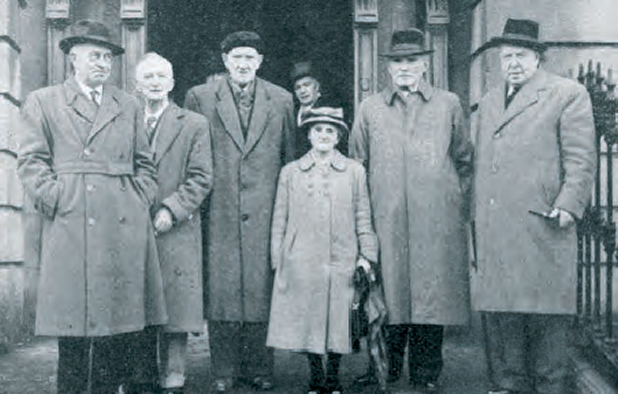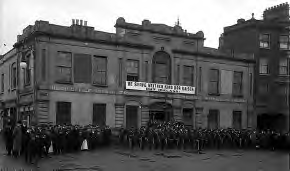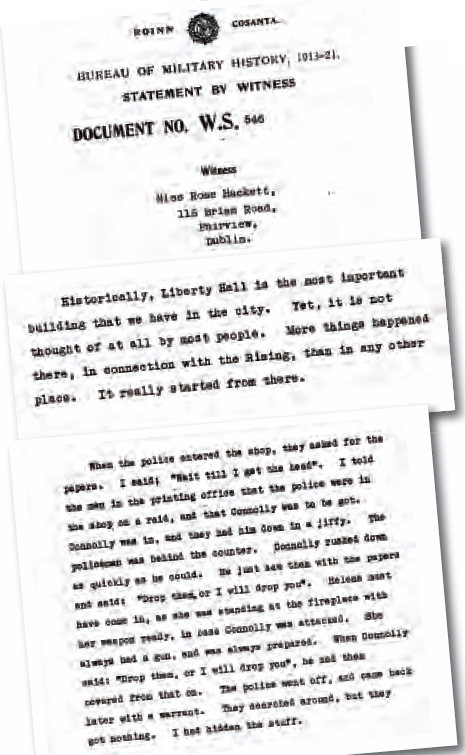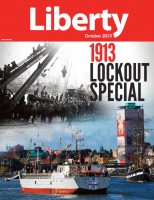
‘I always felt it was worth it, to see the trouble the police had getting [the banner] down. No one was arrested. If it took 400 policemen to take four women, what would the newspapers say?’
Last month Dublin City Councillors voted to name the newest bridge over the River Liffey in honour of trade unionist and Citizen Army member Rosie Hackett, who worked in Liberty Hall from the time of the Lockout until the 1960s.
The Rosie Hackett Bridge will carry the new Luas Cross City line, linking Burgh Quay to Eden Quay, just a few metres from Liberty Hall. Below are extracts from Hackett’s witness statement to the Bureau of Military History in 1951 concerning her activities with the Citizen Army.

IMAGE ABOVE: Irish Citizen Army outside Liberty Hall, Dublin, 1914. TOP IMAGE: Rosie Hackett standing outside Liberty Hall, Dublin with Trade Unionists, 1950s. Credits: National Library
“It was as a result of the big strike in 1913 that I first became attached to Liberty Hall. A workroom was opened to assist girls who had lost their employment as a result of the strike. Miss Delia Larkin had charge of the girls that were working there.
“When Miss Larkin left Liberty Hall, Miss Helena Molony came to take charge, and that is when the work of the women’s section of the Irish Citizen Army started in earnest.”
THE RISING
“A week before Easter, I took part in the ceremony of hoisting the challenge flag over the Hall . . . [Following a route march on Easter Sunday] . . . we formed a circle, and Connolly spoke to us. He was very serious in that speech. . . I remember him saying that every man and woman, and every boy and girl, that had marched this day were now soldiers of Ireland and would be confined to barracks pointing to Liberty Hall.
“That night, I was sent in a lot of times with messages, to where Connolly was. I delivered some messages for him. He would beckon, and I would go in. It must have been in connection with the Proclamation, because the type was being fitted at the time . . . I just went in with messages to the men. I cannot say for whom exactly the messages were, but I was kept busy that night going back and forth with messages.

IMAGE: Rosie Hackett Witness Statement. Credit: National Library
“It was very exciting there. We were under very heavy fire from late on Monday evening. Even when we marked out the first-aid post with a red sign, they did not recognise it and kept firing on us . . .
“On one occasion, I was lying down on one of the beds [in the College of Surgeons], resting myself. The men were trying out some rifles they had found in the College. The people upstairs sent for me to go for a cup of tea . . .
“I had only left the bed, when a man, named Murray, casually threw himself down on it and, whatever way it happened, this bullet hit him in the face. We attended him there for the whole week. He was then brought to Vincent’s Hospital where he died after a week . . .
“After the Rising, Liberty Hall was closed for some time. After our release, we did our best to try and carry on. We started the Fianna Saoirse and other little organisations to try and keep things going.”
FIRST ANNIVERSARY OF CONNOLLY’S DEATH
“On the occasion of the first anniversary of Connolly’s death, the transport people decided that he would be honoured. A big poster was put up on the hall, with the words: ‘James Connolly Murdered, May 12th, 1916’. It was no length of time up on the Hall, when it was taken down by the police . . .
“Miss Molony called us together, Jinny Shanahan, Brigid Davis and myself. Miss Molony printed another script. Getting up on the roof, she put it high up, across the top parapet. We were on top of the roof for the rest of the time it was there. We barricaded the windows.
“Police were mobilised from everywhere, and more than 400 of them marched across from Store Street direction and made a square outside Liberty Hall. Thousands of people were watching from the quay on the far side of the river. It took the police a good hour or more before they got in, and the script was there until six in the evening, before they got it down.
“I always felt that it was worth it, to see all the trouble the police had, in getting it down. No one was arrested. Of course, if it took 400 policemen to take four women, what would the newspapers say?”
IDA MILNE is a social historian (specialising in medical history) who uses oral testimony to explore her research interests. With Dr. Mary Muldowney, she organised the 1913 Lockout Alternative Visions oral history project, training trade unionists and community activists to collect oral histories in their workplace and communities.
PLEASE NOTE: This article was originally published in the Liberty newspaper, the monthly SIPTU newspaper which is distributed to over 50,000 union members, and we have republished it with their very kind permission.
This particular article is taken from the October 2013 special issue, which marks the centenary of the 1913 Lockout.
PDF: Click here to view the entire 1913 Lockout centenary issue.









